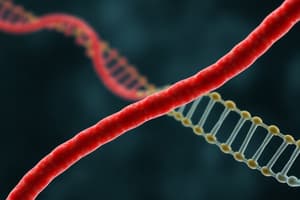Podcast
Questions and Answers
Match the following enzymes with their roles in DNA replication:
Match the following enzymes with their roles in DNA replication:
DNA helicase = Unwinds the DNA double helix DNA polymerase = Synthesizes new DNA strands DNA ligase = Joins Okazaki fragments RNA polymerase = Synthesizes RNA from the DNA template
Match the following levels of protein structure with their descriptions:
Match the following levels of protein structure with their descriptions:
Primary = Linear sequence of amino acids Secondary = Folding into alpha helices and beta sheets Tertiary = Three-dimensional shape of a polypeptide Quaternary = Association of multiple polypeptide chains
Match the following molecular biology techniques with their applications:
Match the following molecular biology techniques with their applications:
PCR = Amplifies specific DNA segments Gel Electrophoresis = Separates biomolecules based on size CRISPR-Cas9 = Genome editing technology DNA sequencing = Determines the nucleic acid sequence
Match the following organisms with their relevance in molecular biology:
Match the following organisms with their relevance in molecular biology:
Match the following key concepts in gene expression with their descriptions:
Match the following key concepts in gene expression with their descriptions:
Match the following base pairs with their complementary partner:
Match the following base pairs with their complementary partner:
Match the following applications of molecular biology with their definitions:
Match the following applications of molecular biology with their definitions:
Match the following roles of RNA in translation with their functions:
Match the following roles of RNA in translation with their functions:
Flashcards are hidden until you start studying
Study Notes
Molecular Biology
-
Definition:
- Molecular Biology is the branch of biology that deals with the molecular basis of biological activity.
-
Key Concepts:
-
DNA Structure:
- Double helix composed of nucleotides (adenine, thymine, cytosine, guanine).
- Antiparallel strands with complementary base pairing (A-T, C-G).
-
DNA Replication:
- Semi-conservative process.
- Enzymes involved:
- DNA helicase (unwinds DNA).
- DNA polymerase (synthesizes new strands).
- DNA ligase (joins Okazaki fragments on the lagging strand).
-
Transcription:
- Process of synthesizing RNA from a DNA template.
- Involves RNA polymerase binding to the promoter region.
- Produces messenger RNA (mRNA).
-
Translation:
- Synthesis of proteins from mRNA.
- Occurs in ribosomes.
- Involves:
- tRNA (transfers amino acids).
- Codons (triplet sequences on mRNA matching tRNA anticodons).
-
-
Gene Expression:
- Regulation of how much and when a gene is expressed.
- Involves transcription factors and epigenetic modifications.
-
Protein Structure:
- Four levels:
- Primary (amino acid sequence).
- Secondary (alpha helices and beta sheets).
- Tertiary (3D shape).
- Quaternary (multiple polypeptide chains).
- Four levels:
-
Techniques:
- PCR (Polymerase Chain Reaction): Amplifies DNA segments.
- Gel Electrophoresis: Separates DNA/RNA/proteins based on size.
- CRISPR-Cas9: Genome editing technology for modifying DNA.
-
Applications:
- Genetic engineering (GMOs).
- Gene therapy (treating genetic disorders).
- Molecular diagnostics (detecting diseases).
-
Key Organisms in Molecular Biology:
- Escherichia coli (E. coli) as a model organism.
- Yeast (Saccharomyces cerevisiae) for eukaryotic studies.
-
Current Trends:
- Synthetic biology (designing and constructing new biological parts).
- Bioinformatics (using computational tools for biological data analysis).
Overview of Molecular Biology
- Molecular Biology studies the molecular foundations of biological functions and processes.
DNA Structure
- Composed of nucleotides: adenine (A), thymine (T), cytosine (C), and guanine (G).
- DNA forms a double helix with antiparallel strands.
- Base pairing rules: A pairs with T, and C pairs with G.
DNA Replication
- Semi-conservative mechanism: each new DNA molecule retains one original strand.
- Key enzymes:
- DNA helicase: Unzips the DNA double helix.
- DNA polymerase: Synthesizes new complementary strands.
- DNA ligase: Connects Okazaki fragments on the lagging strand.
Transcription
- Process of producing RNA from a DNA template.
- Initiated by RNA polymerase binding at the promoter region.
- Results in the formation of messenger RNA (mRNA).
Translation
- The conversion of mRNA sequences into proteins occurs in ribosomes.
- tRNA brings amino acids aligned with codons on mRNA, ensuring proper assembly of the protein.
Gene Expression
- Involves regulation of gene activity—how often and when genes are expressed.
- Influenced by transcription factors and epigenetic changes affecting DNA accessibility.
Protein Structure
- Has four hierarchical levels:
- Primary: Sequence of amino acids.
- Secondary: Formation of alpha helices and beta sheets.
- Tertiary: Overall 3D folding of a single polypeptide.
- Quaternary: Association of multiple polypeptide chains.
Techniques in Molecular Biology
- PCR (Polymerase Chain Reaction): Method to amplify specific DNA segments.
- Gel Electrophoresis: Technique for separating nucleic acids and proteins based on size.
- CRISPR-Cas9: Advanced genome editing tool for precise DNA modifications.
Applications
- Genetic engineering leads to the creation of genetically modified organisms (GMOs).
- Gene therapy aims to treat and potentially cure genetic disorders.
- Molecular diagnostics facilitate the detection of health conditions through biological markers.
Key Organisms
- Escherichia coli (E.coli): Widely used as a model organism in research.
- Saccharomyces cerevisiae: A yeast species important for studies in eukaryotic biology.
Current Trends
- Synthetic biology: Focus on creating novel biological parts and systems.
- Bioinformatics: Utilization of computational methods for analyzing biological data.
Studying That Suits You
Use AI to generate personalized quizzes and flashcards to suit your learning preferences.




